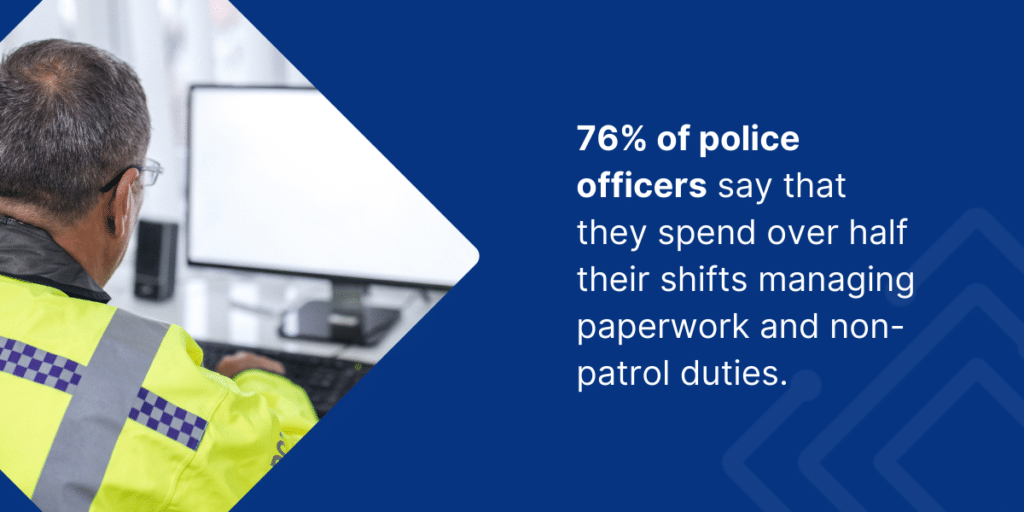Law enforcement agencies are embracing police technology to streamline labor management, enhance efficiency, and improve public safety. From real-time scheduling to automated timekeeping, modern solutions are transforming the way officers operate. By reducing administrative burdens and optimizing staffing, agencies can allocate more time to crime prevention and community service.
The Growing Role of Technology in Police Operations
The evolution of police technology has led to significant improvements in operational efficiency. Law enforcement agencies increasingly rely on digital tools for communication, scheduling, and data management.
Technology-driven emergency response systems have resulted in a 15% improvement in operational efficiency. This highlights the crucial role of automation in reducing delays and improving coordination among officers.
Key Innovations in Police Technology
- Real-time workforce scheduling ensures officers are deployed efficiently.
- Automated time-off approvals streamline administrative processes.
- Mobile workforce apps allow officers to access schedules and submit requests on the go.
- Integrated data systems centralize officer information for improved decision-making.
- Advanced communication tools enhance collaboration during emergencies.
- Predictive analytics help anticipate crime patterns and allocate resources strategically.
Technology in the police force is not just about efficiency—it’s about creating safer communities by enabling faster, smarter decision-making
Reducing the Administrative Burden with Workforce Technology
One of the major challenges facing law enforcement agencies is the heavy administrative burden placed on officers. According to the Bureau of Justice, 73% of law enforcement officers report spending a significant portion of their shift on administrative tasks like paperwork, scheduling, and time-off requests. Even more concerning, 76% of officers indicate that they spend over half their shifts managing these non-patrol duties.
Managing officer schedules, approving time-off requests, and ensuring compliance with reporting regulations are essential tasks but also highly time-consuming. Moreover, officers frequently navigate multiple systems to complete these tasks. Did you know that 47% of officers log into multiple platforms daily, which 82% of them report negatively impacts their ability to perform efficiently.
The solution lies in the adoption of digital workforce management platforms. These systems automate key functions, such as time-off approvals, overtime scheduling, and compliance reporting, reducing administrative overhead and allowing officers to focus on fieldwork. By consolidating scheduling, payroll, and timekeeping into one platform, agencies simplify their operations and improve productivity.

Managing Surges in Officer Demand
Police departments often face unpredictable surges in demand, particularly during large-scale events, emergencies, or federal-level activities. Efficiently managing these surges is critical for maintaining public safety and optimizing resources.
Challenges such as unpredictable demand—whether for crowd control at protests or increased security at large public events—require rapid adjustments. Sudden increases in overtime strain agency budgets and contribute to officer fatigue. Coordinating shifts for large events while maintaining regular patrol coverage becomes a logistical challenge.
New police technology address these challenges through real-time scheduling adjustments and improved overtime management. Automated workforce management platforms enable agencies to reassign officers to high-demand areas without compromising coverage elsewhere. These systems also forecast overtime requirements based on historical data, helping agencies better plan their staffing and budgets. Specialized software can even track overtime during federally reimbursable events, streamlining the grant application process.
As evidenced by Clackamas County Sheriff’s Office, implementing these solutions led to an 87% reduction in overtime costs, saving thousands of dollars and improving overall efficiency during large-scale events.
Improving Workforce Scheduling for Increased Efficiency
Efficient workforce scheduling is key to balancing coverage and compliance while managing the complexities of law enforcement operations. However, outdated, manual scheduling methods often lead to last-minute shift changes, excessive overtime, and understaffing. Digital scheduling systems can reduce overtime costs by 25% and improve schedule accuracy by 35%.
The use of automated scheduling also reduces the occurrence of grievances, as officers experience fewer conflicts over shift assignments. Manual scheduling often leads to complaints about unfair distribution of shifts, poor work-life balance, or overburdened officers. In contrast, automated police technology systems ensure that scheduling is done based on clear, predefined rules, making the process more transparent and consistent. As seen in a 25% reduction in grievance filings after implementing labor-management cooperation programs.
Automated systems provide real-time visibility of workforce availability, ensuring that the right officers are scheduled for the right shifts. These platforms also enable self-service scheduling, allowing officers to swap shifts or request time off directly without the need for administrative intervention.
Time and Attendance Tracking for Accurate Payroll
Accurate time tracking is essential for ensuring that officers are compensated properly and that police departments remain compliant with labor laws. Manual timekeeping methods are often prone to errors such as “buddy punching” or delays in payroll processing.
Automated time and attendance systems address these issues by providing real-time tracking of officer hours, reducing payroll errors by 40% and speeding up approval times by 50%. These digital systems also eliminate manual entry mistakes, ensuring compliance with overtime policies and providing real-time tracking of work hours and officer locations, improving accountability.
Qualification Management for Optimized Workforce Deployment
In addition to managing schedules and timekeeping, police technology plays an important role in ensuring that officers possess the necessary skills and certifications for their assignments. Many law enforcement agencies struggle to track officer qualifications, often relying on disorganized spreadsheets or manual systems that fail to keep up with certification renewal dates.
A centralized skills management system addresses this by tracking officer training, certifications, and requalification deadlines. Automated systems send notifications when certifications need renewal, ensuring that only qualified personnel are assigned to specialized tasks. By ensuring that officers have up-to-date skills, these systems help reduce compliance risks and ensure public safety.
How a Large Public Safety Agency Standardized Workflows and Cut Costs
One of the most compelling examples of police technology improving operational efficiency comes from a large public safety agency that successfully streamlined its workforce management processes using Indeavor’s platform. Faced with rising overtime costs, inconsistent scheduling practices, and the administrative burden of managing multiple legacy systems, the agency needed a comprehensive solution to standardize workflows and enhance resource allocation.
Before implementing Indeavor’s workforce management system, the agency grappled with siloed data, manual scheduling errors, and difficulties in maintaining compliance with labor regulations. These inefficiencies not only led to unnecessary overtime expenses but also increased the risk of officer fatigue and staffing gaps during critical operations.
By transitioning to Indeavor’s centralized scheduling platform, the agency was able to automate complex workforce management tasks, including time-off approvals, overtime scheduling, and compliance tracking. This shift resulted in a 40% reduction in administrative time spent on scheduling and a significant decrease in overtime costs. Additionally, the platform provided real-time visibility into workforce availability, enabling leadership to make data-driven decisions and optimize staffing levels based on operational demands.
The system also improved compliance and accountability. With automated audit trails and accurate time tracking, the agency ensured that officers were assigned shifts aligned with their certifications and qualifications, reducing liability risks and promoting officer safety.
This case study highlights how adopting modern police technology not only enhances operational efficiency but also delivers measurable cost savings and improves overall workforce management. Agencies looking to reduce administrative overhead, cut overtime costs, and improve scheduling accuracy can benefit from similar technology-driven strategies.

The Future of Police Technology
The future of police technology is bright, with innovations continuing to enhance law enforcement operations. By reducing paperwork and manual processes, improving scheduling and workforce allocation, and increasing accuracy in payroll and compliance, technology is poised to revolutionize how law enforcement agencies operate.
As agencies continue to adopt modern workforce management tools, they will see further improvements in efficiency, resource optimization, and public safety. The advancement of police technology promises to make law enforcement agencies more agile and better equipped to meet the demands of an ever-changing landscape.
For agencies looking to optimize their workforce management, Indeavor offers cutting-edge solutions. Indeavor’s workforce management platform streamlines scheduling, time tracking, and compliance, allowing officers to focus on their essential work rather than administrative tasks. By adopting Indeavor, police departments can reduce operational costs, improve efficiency, and enhance overall public safety. Embrace the future of police technology with Indeavor to ensure your agency stays ahead in an ever-evolving environment.
By embracing these advancements, law enforcement agencies can optimize their resources, reduce operational costs, and ultimately enhance the safety and well-being of the public.
About the Author
Claire Pieper is the Digital Marketing Specialist for Indeavor. In her role, she specializes in crafting strategic and engaging content, ensuring that customers are well-informed. Claire is dedicated to enhancing the customer experience and optimizing the user journey through Indeavor’s solutions. To learn more or get in touch, connect with Claire on LinkedIn.







